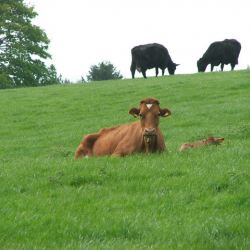Who would think that meat could be such a divisive issue? Its advocates praise its protein content or nutritional value; its detractors while grounded in the past on ethical concerns have increasingly raised the alarm over its environmental footprint. A new whitepaper by the Breakthrough Institute [1] suggests a new direction. Let me first lay out their argument.
As the global population grows and income rises, eating habits among the developing countries shift, increasing their demand for dietary protein from animals. For many years, supply responded to demand to require us to feed more and more meat sources, in this particular instance, ruminants, primarily cattle. From an environmental perspective, ruminants are responsible for 43% of all agriculturally derived green-house gases. From a land use perspective, their care and feeding use roughly half of all agricultural land, some to raise crops specifically to feed them (estimated at 20% of total crop production) but pasture for foraging is the single use of land. For a long time, demand resulted in more supply and more land converted into pastureland.
Those new pastures came from deforestation or converting large tracts of natural grassland. Deforestation and degradation of native grasslands are felt to result in loss of diversity, the release of carbon stores from soil and plants and a diminishing source for carbon sequestration – a significant concern in the modeling of climate change. But beginning about 20 years ago, pastureland stopped expanding and began contracting; first in the high-income countries, then in middle and low-income countries.
When viewed over time, the amount of pastureland follows a typical sigmoid shaped growth curve, beginning low, rising exponentially, and then leveling off. While the global aggregate use of pasture has plateaued, contraction is heterogeneous, with some countries having more contraction than others. Despite the variations, there is enough of a decrease that many of the climate change models using the trend of increasing pastureland, true before this century, are less and less reliable. One fly in the ointment as it were, is that the developing countries, especially those of sub-Saharan Africa are only at the beginning of their growth phase and will be needing more and more pastureland to supply their citizens. And while reforestation and the return of native grasslands is good, preventing deforestation and grassland loss is even better.
Increases in productivity, what the Breakthrough Institute terms the Livestock Revolution, is what allows more production with less pastureland. In their words, pastureland is decoupled from production, but in truth, it is not so much uncoupled as reduced. Productivity can increase in several ways. You can increase the number of cattle raised per acre, termed stocking density, but that is not sustainable as overgrazing resulting in deterioration of the forage quality, sets a natural limit. You can breed for higher yields, as we have with chickens, although many would argue that today’s chicken is far different than the one created by natural selection. And you can improve the quality of the food cattle eat much in the way humans attempt to improve their health and diet by the quality of the foods they eat.
The Breakthrough Institute’s solution framework involves all three of these levers.
“Ensuring that animals receive an energy-rich and nutritionally balanced diet is essential for improving animal yields, and greater productivity of forages (grasses and other plants for grazing) and feed crops means more feed can be grown on less land. Additionally, cattle can be bred to be higher-yielding and better adapted to regional climates. Finally, protecting animals’ health and welfare makes them more productive.
There is no one-size-fits-all pathway towards higher livestock productivity. Every region and animal operation will need to identify what practices are most suitable and effective for them.”
Many countries still operate below the efficiencies that high-income countries already possess and which produced the decreases in necessary pastureland, at the very minimum those technologies can be transferred. And that transfer does not need to raise the specter of technologic imperialism or colonialism, as the report states,
“Of course, while increasing productivity is an important objective for reducing land- use change, it is one of many possible social, economic, cultural, and environmental goals, and intensification efforts should respect the integral role of livestock in the lives, livelihoods, and cultures of local communities.” [Emphasis added]
This intensification of production is not a panacea. Factory-farms have been economically efficient but not as ecologically responsible. Feedlots need not be animal versions of tenements; animal health need not be sacrificed wholly for financial savings. Sustainable food sources are not binary choices, it is not a question of entirely replacing meat, though the Impossible Burger is making inroads; nor is it a continuation of the status quo. It requires a more nuanced approach; at least I believe that is what this whitepaper is suggesting. As with Norman Borlaug’s Green Revolution in crop productivity, newer technologies can help us manage a Livestock Revolution that is productive, financially efficient, and a better ecologic steward.
[1] The Breakthrough Institute's philosophy is ecomodernism, “humans can protect nature by using technology to 'decouple' anthropogenic impacts from the natural world; ...[affirming] one long-standing environmental ideal, that humanity must shrink its impacts on the environment to make more room for nature, while we reject another, that human societies must harmonize with nature to avoid economic and ecological collapse."
Source: Achieving Peak Pasture Shrinking Pasture’s Footprint by spreading the livestock revolution The Breakthrough Institute

